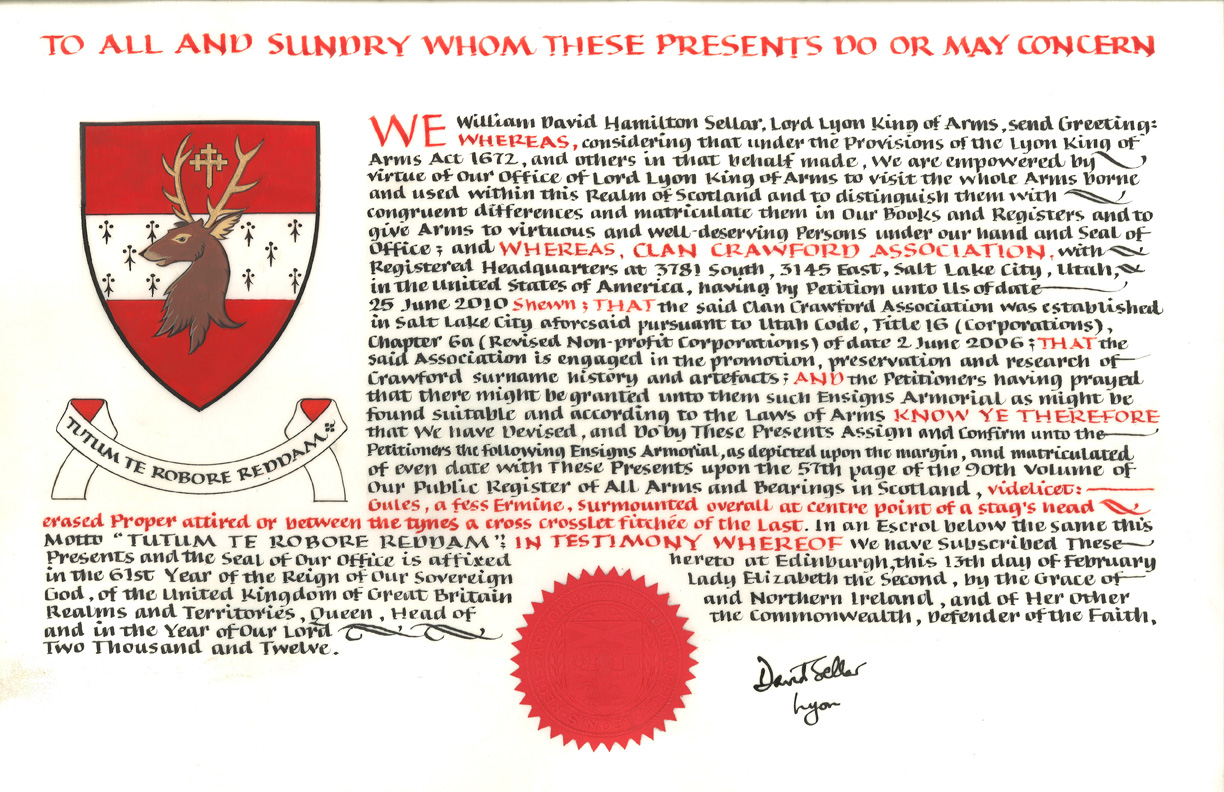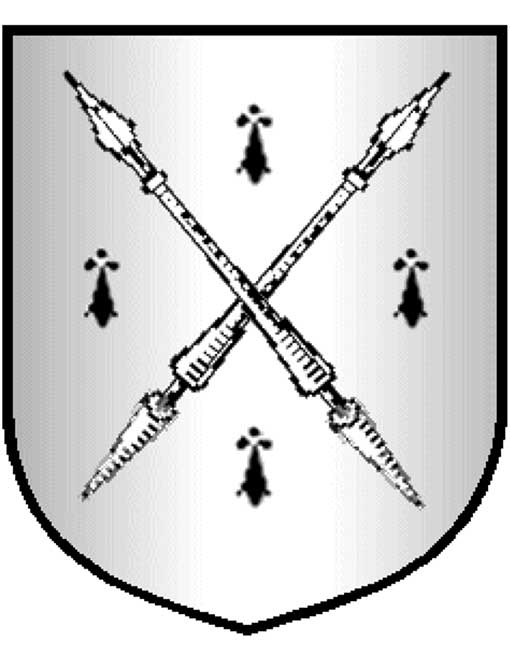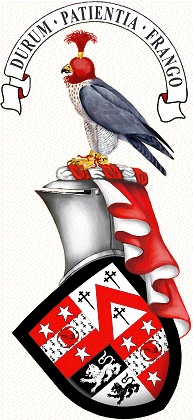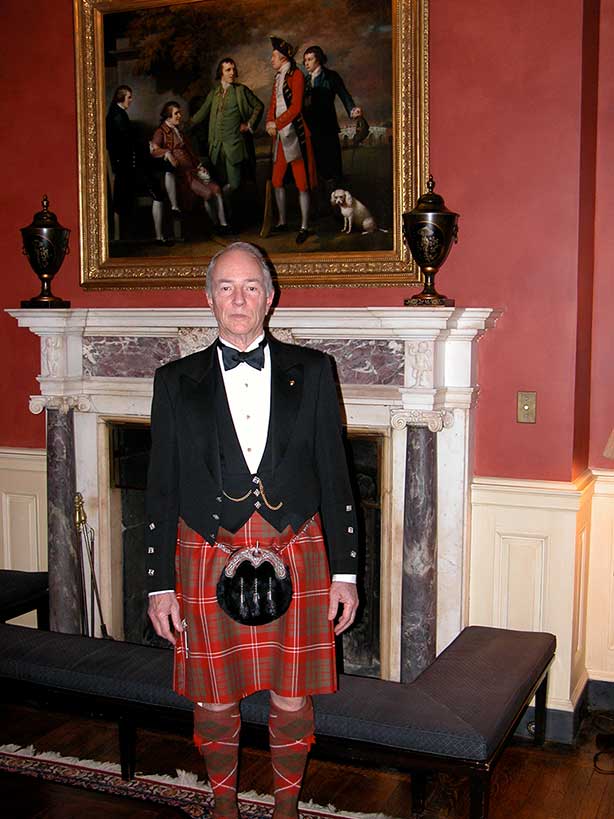The Heraldic History of Clan Crawford

Above are the arms of the Clan Crawford Association as granted by the Lord Lyon of the Court of Scottish Arms in 2012. In this section, we particularly acknowledge Raymond Crawfurd’s contributions on Crawford heraldry. Below the topic head “What is our Coat of Arms?” there is a link to the document presenting the results of his research on Crawford heraldry titled “The Arms of the Crawfurd Family”. In it Raymond presents the individual versions of Crawford arms used by Crawfords of the diverse cadet lines. Kevan Crawford edited the materials and added graphic images for each of the shields based on the descriptions Raymond had found in manuscripts and old books on Scottish heraldry.
What is the Clan motto? Three mottos commonly associated and used to represent Crawfords have been: “Tutum te robore reddam” — My strength will keep you safe “Sine labe nota” — A mark [of distinction] without a stain [of infamy]. “God shaw ye right” — God show the right. Mottos are as much part of the arms as crest and shield, though often not recorded. There are at least ten different mottos used by the Crawfords, and the above three are some of them. If we have an officially recognised Chief, the crest and motto on the Clan’s “belt and buckle” badge will be those of the Chief – for example if Sir Robert is elected to be Chief he might decide it would be his crest which is an ermine and the motto “Sine labe nota”. The motto “God shaw ye right” comes from Captain Thomas of Jordanhill. The most popular one associated with Crawfords is the first listed above and has typically been used on the clan crest. Technically, though, it represents the Dalmagregan branch of the House of Crawford.
What is the Clan crest? The word “crest” is often used as a general word for a coat of arms but really it refers only to that part of the design that is above the shield and the helmet, if there is one. There is a protocol for the use of crests as much as for shields. There is only one Crawford tartan, but a dozen or more crests. The buck’s head is associated with the Dalmagregan Branch. Generally a crest is common to one branch of a family or clan. For example, the hooded hawk is the crest used by all the Ardmillan Crawfords. A clansman can display his crest and motto in the form of a “belt and buckle” badge. The badge consists of the crest surrounded by a belt on which is inscribed the motto. A clansman will use his own crest and motto if he has one, but if not, he uses the crest and motto of his Chief to show his loyalty to the clan and the Chief. The currently common belt and buckle badge used by clan members to identify them as Crawfords is below left and properly belongs to the Dalmagregan branch of the family.



What is our Coat of Arms? The terms “coat of arms” or “arms” refer to the heraldic design shown on a shield or flag. Arms are regulated by the laws of the country in which they are used. In Scotland they are regulated by Lord Lyon under Scottish law. Outside Scotland, Lord Lyon has no jurisdiction. In America, for example there is no heraldic law, and people are free to assume any arms they like as long as they don’t infringe designs that are registered for national or state organisations or protected by patent. In Scotland arms are protected by law and, to be used, they have to be granted or matriculated (awarded with appropriate differences) by Lord Lyon. Generally each family or clan with a right to arms will have a basic and distinctive design, known as the “stem” arms, which are usually borne by the Chief or head of the family. Other members of the family will bear “differenced” versions of the stem arms, still recognisable as derived from the stem arms, but with their own distinctive changes. Common forms of differencing include: 1) the addition of colored borders, 2) the addition of one or more charges, 3) changes in colour or edging of elements of the design, and 4) quartering with the arms of related families”. The matter of the Clan Chief’s arms is complex. Generally, but not always, the Chief will bear the undifferenced stem arms.The most obvious example of an exception is the British Royal Arms which quarter the arms of England, Scotland and Ireland. Several Clan Chiefs use either the plain arms of the family or quartered arms or even arms with many partitions indicating important marriages. The three undifferenced basic coat of arms granted Crawfords and used, often differenced, by their descendants are as follows:



Arms belong to the individual not to the family, so at any one time, the individual members of a family will bear arms that are different from each other. During the lifetime of the head of the family, his heir will use a temporary difference which he sheds on the death of his father, when he inherits the right to his father’s arms. Below are the arms of our probable future commander and chief of clan, Sir Robert Craufurd, 9th Baronet of Kilbirnie (left) and the Association’s Vice President Raymond Crawfurd’s arms (on the right). They are examples of the arms of a younger member of his cadet line (Crawfurds of Ardmillan). Individuals living in different countries can use the same arms. In the mediaeval period, a family living in England, bearing the surname of Wallis, was using arms identical to those borne by the Crawfords in Scotland.


The Crawfords are a large family and there are many differenced coats of arms that have been borne by Crawfords over the centuries. These have been collected and recorded in “Arms of Branches of the Crawfurd family” for which there is a link immediately below. The spelling ‘Crawfurd’ in the title is how Raymond used it in the original following his own family’s traditional spelling of the surname.
What tartan should I wear? There are no strict rules on who has the right to wear a particular tartan. People normally wear only the tartan (if any) of their surname, or a “district tartan” connected with where they live or from where their family came. Wearing a particular clan tartan indicates that the wearer bears an allegiance to the chief of that clan. A tartan which uses the name of a clan may only do so if the chief of that clan has given his approval to the particular design. There is no official government register of tartans. Records of designs are maintained by the Scottish Tartans Authority, a non-governmental institution.



There are three main Crawford tartans to consider wearing: The first is modern, the second is ancient, and the third is known as Arisaid (from left to right as they appear above). Generally, the modern tartan is in the darker colors and the ancient tartan in the same pattern is in lighter colors; the first uses chemical dyes while the second uses natural dyes. The pattern of the cloth is what makes a tartan unique. The arisaid tartan is a recent innovation developed for use in dance competitions. It reverses some of the red and white threads, though the counts remain the same. The arisaid tartan is also used by women to complement an ankle length dress that includes a tartan shawl or long sash worn over the dress. Any one of the other tartans can also be worn in this manner.  There are also tartans called Ayrshire and Lanarkshire, for districts of Scotland. There are national Scottish tartans: Black Watch, Hunting Stewart, Jacobite, etc. And there is the St. Andrew’s tartan and various province, state, and county tartans. Those whose surname is Crawford seldom opt for national or district tartans because it is more appropriate for clan members to wear the tartan of their surname. Below is the photo of one of the Association founding members, Hardin Lake Crawford, III, in full dress Crawford kilt, though he wears an orange shade Crawford tartan known as “weathered”.
There are also tartans called Ayrshire and Lanarkshire, for districts of Scotland. There are national Scottish tartans: Black Watch, Hunting Stewart, Jacobite, etc. And there is the St. Andrew’s tartan and various province, state, and county tartans. Those whose surname is Crawford seldom opt for national or district tartans because it is more appropriate for clan members to wear the tartan of their surname. Below is the photo of one of the Association founding members, Hardin Lake Crawford, III, in full dress Crawford kilt, though he wears an orange shade Crawford tartan known as “weathered”.

One taboo in wearing tartan is wearing those of two different clans. It has been suggested in the past that a man could wear a tie in his mother’s clan tartan. This is not correct. Even wearing the same tartan tie as one’s kilt is discouraged. The outfit above is a dress version and provides a standard for what is appropriate to wear with the kilt. One can also see tartan kilts for various clans on the websites of companies dedicated to the sale of Scottish clan tartans and other items such as belts, pins, sporrans, shirts and even shoes and the long socks.
What is the Clan plant?

Boxwood – In the days prior to the tartan registry and other modern formalities, clans chose a plant to represent them. All members wore a sprig of the plant as they marched or went into battle. Each clan chose a different and distinctive plant. Boxwood was the plant chosen by Crawfords to wear to identify the individual associated with our clan or house.